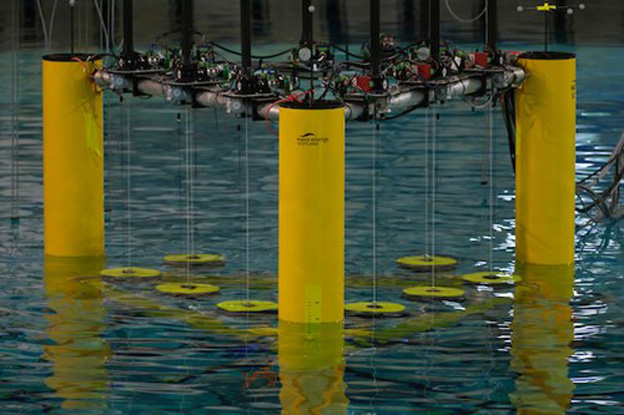Following the promising range of potential benefits identified in the scenarios within the “Wave and Floating Wind Energy - Opportunities for Sharing Infrastructure, Services and Supply Chain” report supplied by Offshore Wind Consultants (OWC) Ltd, Wave Energy Scotland (WES) has begun a series of tank tests at the University of Edinburgh’s FloWave facility. There are some clear synergies between the technical requirements and suitable locations for floating wind and wave energy. To maximise the future cost reduction in both sectors, it may be effective to share some of the sub-systems and infrastructure between these two technology types. Versatile wind and wave platforms (where projects are in the same region and use common platform designs) may therefore provide an attractive solution to both sectors.
The overall improvement in the physical and numerical understanding of the design drivers will enhance the support WES can offer to developers to optimise their design solutions and to enable future MW-scale multi wave absorber platform systems to be developed.
Alongside this, offshore energy in Scotland was recently bolstered by the leasing of 30GW of ScotWind projects, and several of these leased sites have an attractive wave energy resource which may support versatile wind and wave platforms in the future.
The tank tests currently being completed by WES use sea states which are representative of one of these future floating wind lease sites on the west coast of Scotland, leased through the ScotWind programme and which has an appropriate water depth and wave resource for large scale wave energy exploitation.
The physical model used for the testing incorporates multiple identical wave energy absorbers mounted onto a semi-submerged, triangular floating platform. The platform is generic but similar to many concepts under development within the floating wind sector, while each absorber is a simplified version of a submerged pressure differential device. The absorbers have taken inspiration from AWS Ocean Energy’s Archimedes Waveswing; a submerged wave power buoy which has been developed and funded through WES’s Novel Wave Energy Converter Programme.

Triangular floating platform design with AWS inspired absorbers undergoing tests at FloWave. Image source: WES
The modular design of the physical model enables a varying number of absorbers to be mounted to the triangular platform in a number of different positions. The first round of tests have been carried out with configurations of 9 and 3 absorbers, with future options being considered based on the findings from the initial testing and numerical model runs. The physical model also allows for different station-keeping options to be employed, in order to assess the impact this has on behaviour of both the platform and absorbers.
The outcomes of the tests will improve the understanding of the performance and physical interaction between multiple wave absorbers on a floating platform, while also supporting the validation of numerical models developed in parallel to the tank testing. The numerical models will allow subsequent investigation of key drivers such as annual energy performance, and the exploration of platform configurations not tested in the wave tank.
Dr Thomas Davey, Principal Experimental Officer said:
“WES, through its technology development programme, have been working with FloWave and the University of Edinburgh since its inception to develop the requirements for robust testing campaigns. It’s great to see a focus now on an ambitious new approach as they complete their own tank testing to inform the future development path of versatile platform designs.”
Elva Bannon, Research and Engineering Manager said,
“Recent reports, and support from Scottish Government, show the vast opportunity for collaboration and cross over between floating wind and wave energy. We are taking the initiative to carry out research in the area by completing a testing campaign to progress the sector’s understanding of how these versatile platforms may perform, which can help reinforce the economic analysis. We are excited to share further results of this project over the coming months.”
KeyFacts Energy Industry Directory: Wave Energy Scotland (WES)
 KEYFACT Energy
KEYFACT Energy